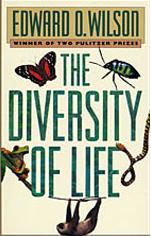
The Diversity of Life
E. O. Wilson
424 pages
published in 1992
The Diversity of Life is the first E. O. Wilson book I've ever read and I finished it impressed. Writing science books aimed at a lay audience is not an easy job to do, having to explain difficult concepts to an audience of whom you can't assume they have the background to understand them immediately. And you need to do this without boring your audience or telling too many lies-to-children. E. O. Wilson manages to do this with a concept as big and fuzzy as biological diversity, is a tribute to his writing.
Wilson is a biologist, who first rode to a certain amount of fame and infamity in the seventies, for popularising the concept of sociobiology. As a biologist he spent a large part of his career studying social insects, especially ants, from the study of which he also derived some of his ideas about sociobiology. For his research he spent quite some time in developing countries, seeing the ongoing destruction of wild habitats up close, so it's no wonder that he became a passionate environmentalist.
What E. O. Wilson does in The Diversity of Life is to first explain the concept of biodiversity, then to explain why it is important to keep biodiversity high and finally examine the impact humanity has had and still has on ecosystems around the world, why it's important to migitate this impact and how we might do so. Unfortunately, this was written in 1992, during the previous cycle of high media attention for the environment, which ultimately led to little real action, which makes for some bittersweet reading. Hard enough to read about the ongoing extinction of perhaps the majority of existing species in the world without knowing that the past sixteen years have been mostly wasted doing anything about it.
Setting aside the ecological message of it, The Diversity of Life is an incredibly fascinating book. Wilson explains how resilient life is by taking Krakatau as an example. After the famous 1883 explosion the island was completely devestated and lifeless, but it did not take long for life to re-establish itself. However, the ecosystem that slowly emerged was much less stable than before the eruption, with species arriving and dying out shortly afterwards on a regular basis; even now it's still in flux and nowhere near as mature as on similar islands elsewhere.
On Earth as a whole, there have been five major extinction events, of which the one that killed off the dinosaurs is the most famous. After each, it took millions of years for new, mature ecosystems to develop, where new species or minor older species get the chance to "take over" by evolving into different niches. This process is called adaptive radiation. It's what created the wide variety of finch species on the Galapos Islands for instance.
As said, mature ecosystems take eons to create themselves. But when they do, they are incredibly rich in diversity. And such diversity is not just interesting, or perhaps even commercially valuable, but also needed for our own survival. As Wilson explains, we really only know the merest fraction of the total number of species inhabiting our world, and an even smaller number of species we know more about than their name and description. We don't even know at which species are vital to our own survival... All we know is that if you take away enough key species, ecosystems crash, even if they still look large and viable enough to survive, that ecosystems need room and can get small enough to die, even if all key species are present. And yet we are still continuing to destroy our last remaining pristine wildernesses. Nor should we in the comfortable west be smug in our judgement of what's going on in a country like Brazil or Indonesia: we've already killed off most of our original ecosystems after all.
So yeah, reading this is a bit of a downer, but despite this I'd still recommend it. Wilson is quite good in laying out all these issues in a calm and understandable manner, and it's no good closing our eyes to this disaster.
Read more about:
E. O. Wilson,
The Diversity of Life,
biology,
evolution,
book review